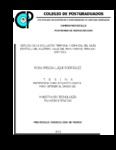Estudio de la evolución temporal y espacial del nivel estático del acuífero Valle del Mayo para el período 1997-2011
Abstract
El monitoreo del nivel de las aguas subterráneas, provee de importante información para la caracterización del abatimiento, incremento o estabilización de los volúmenes del agua subterránea en una región. Los cambios en los niveles de agua subterránea son provocados por los patrones de consumo de agua, las afectaciones en la recarga y los factores climáticos; la identificación y cuantificación de estos cambios son indispensables para el manejo sustentable de este recurso. En este estudio se evaluó el comportamiento del nivel y la distribución de él agua subterránea en el área del distrito de riego 038 rio Mayo, Sonora, México, para el periodo del año 1997 a 2011; mediante la construcción e integración de mapas de isolineas del cambio y la distribución de los niveles del agua subterránea en el periodo. Los mapas fueron generados a partir de mediciones georefenciadas del nivel estático (NE) durante 1997 a 2011 de una muestra de 89 pozos de los 280 pozos que se encuentran en el área del distrito de riego. Los mayores niveles estáticos se encuentran en la parte norte del Distrito en las zonas cercanas a la ciudad de Navojoa y el poblado de Tesia con niveles mayores a 30 m en promedio y disminuyen hacia el sur con niveles de 3 a 4 m en promedio en los poblados Huatabampo, El Jupare y Etchoropo. Para el caso de la profundidad del nivel estático el Distrito presenta valores promedio de 7 a 12 m en la mayor parte de su área; aunque también existe una pequeña parte profunda al sur este cerca del Rancho Chapo que llega hasta los 22 metros. La tendencia actual (2011) es que el nivel estático en el distrito está aumentando y alcanzando un nivel muy similar del inicio del periodo de análisis (1997), después de un descenso del nivel estático en años anteriores; sin embargo aún los niveles actuales son un poco menores, a los de 1997. Espacialmente esto se refleja en que comparado con 1997, actualmente el nivel estático disminuyo en un 93% del área del distrito, aunque en mayor proporción ( 89%) esta disminución ha sido de 1 a 2m; en cambio solo en un 7 % del área del distrito el nivel estático ha aumentado. _______________ SPATIAL AND TEMPORAL EVOLUTION STUDY OF THE STATIC LEVEL IN THE MAYO VALLEY AQUIFER FOR 1997-2011. ABSTRACT: The monitoring of the groundwater level provides important information for the characterization of the falling, increase or stabilization of volumes of groundwater in a region. Changes in groundwater levels are caused by water consumption patterns, the effects on the recharge and climatic factors, identification and quantification of these changes are essential for the sustainable management of this resource. This study evaluated the behavior of the level and distribution of it underground waters in the area of the Irrigation District 038 Rio Mayo, Sonora, Mexico, for the period of 1997 to 2011; Through the construction and integration of maps of isolines of change and the distribution of groundwater levels in the period. The maps were generated from the static measurements georefenciadas during 1997-2011 from a sample of 89 wells of the 280 wells that are in the area of the irrigation district. The highest levels are static in the northern part of the district in the areas close to the city of Navojoa town and Tesia with levels greater than 30 m on average and decrease southward with levels of 3-4 m on average in the Huatabampo villages, The Júpare and Etchoropo. For the case depth of the static level the district presents average values 7-12 m in most of the area, although there is also a small part deep south near Rancho Chapo this goes up to 22 meters. The current trend (2011) is that the static level is increasing and reaching at a similar level to the start of the analysis period (1997), after a decline of the static level in previous years, but even the current levels are slightly lower, the 1997. Spatially this is reflected in today compared to 1997 the static level has decreased in most part of the District 93%, the largest proportion (89%) of the surface of the aquifer has decreased from 1 to 2 m, whereas only 7% of the aquifer area the static level has increased.
Collections
- Tesis MC, MT, MP y DC [274]

